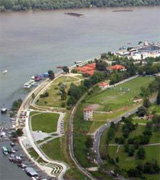 Belgrade was first founded as a Celtic settlement
that later became part of the Roman Empire. It was conquered first by the Byzantine
Empire and then by the Kingdom of Bulgaria and known, from this moment onwards,
as Beligrad. In the Middle Ages it became part of the Kingdom of Serbia. It
was occupied first by Hungary and shortly afterwards by the Ottoman Empire,
under whose rule it remained for almost three centuries. Austria occupied it
no less than three times. With the flight of the last Turks in 1867 and the
proclamation of the Kingdom of Serbia in 1882, Belgrade became a key city in
the area of the Balkans. Belgrade grew and was modernised extremely rapidly
during the First World War. In the Second World War, after the heavy bombing
by the Germans that caused thousands of victims, the city was occupied by Hitler's
troops until October 20th 1944, when it was liberated by the Yugoslav partisan
guerrilla warfare and the Red Army. Belgrade developed and expanded rapidly
after the war, transforming itself into a great industrial city. Belgrade was
bombed by NATO air forces, suffering considerable damage, during the war of
Kosovo in 1999. In the year 2000, the many protests held in Belgrade led to
the resignation and the consequent arrest of Slobodan Milosevic. Today it is
the capital city of the Federal State of Serbia-Montenegro. Belgrade was first founded as a Celtic settlement
that later became part of the Roman Empire. It was conquered first by the Byzantine
Empire and then by the Kingdom of Bulgaria and known, from this moment onwards,
as Beligrad. In the Middle Ages it became part of the Kingdom of Serbia. It
was occupied first by Hungary and shortly afterwards by the Ottoman Empire,
under whose rule it remained for almost three centuries. Austria occupied it
no less than three times. With the flight of the last Turks in 1867 and the
proclamation of the Kingdom of Serbia in 1882, Belgrade became a key city in
the area of the Balkans. Belgrade grew and was modernised extremely rapidly
during the First World War. In the Second World War, after the heavy bombing
by the Germans that caused thousands of victims, the city was occupied by Hitler's
troops until October 20th 1944, when it was liberated by the Yugoslav partisan
guerrilla warfare and the Red Army. Belgrade developed and expanded rapidly
after the war, transforming itself into a great industrial city. Belgrade was
bombed by NATO air forces, suffering considerable damage, during the war of
Kosovo in 1999. In the year 2000, the many protests held in Belgrade led to
the resignation and the consequent arrest of Slobodan Milosevic. Today it is
the capital city of the Federal State of Serbia-Montenegro.
|

